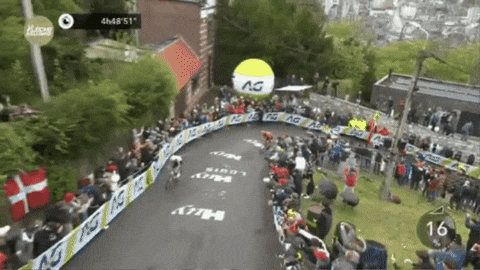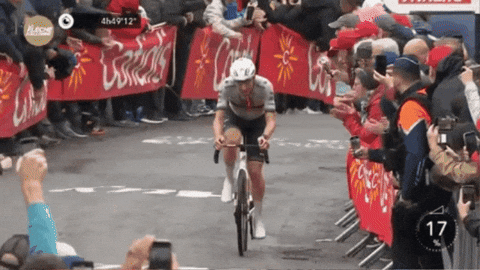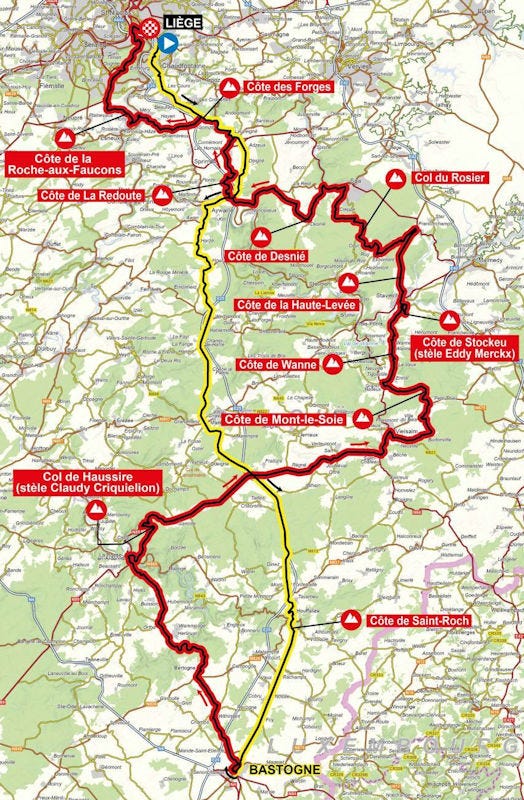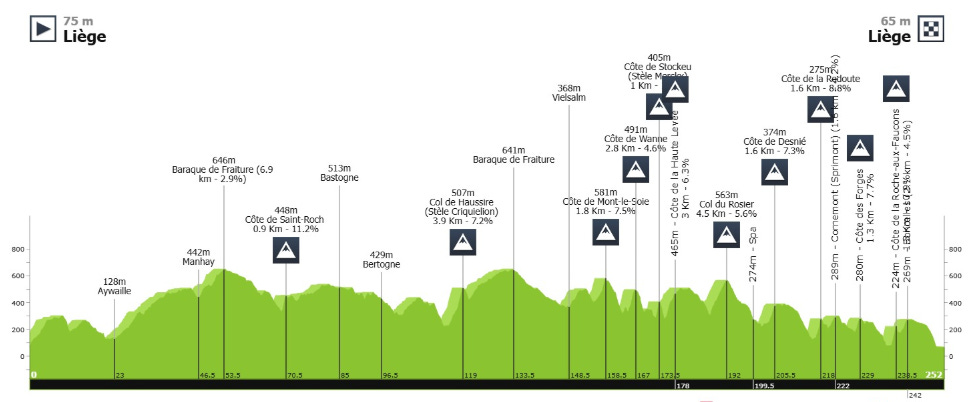Weekend Preview: Liège-Bastogne-Liège
Plus, what Tadej Pogačar's dominant performance at the mid-week La Flèche Wallonne tells us about what to expect at Sunday's final Spring Classic
Weekend Preview: Liège-Bastogne-Liège
This Sunday, Liège-Bastogne-Liège, aka La Doyenne, the almost impossibly hard one-day race through the Ardennes region of Belgium, from Liège to Bastogne and back, will mark the end of the one-day Classics season and bring us slightly closer to the beginning of the three Grand Tours. In addition to a challenging course, the race will feature the third showdown between two official top-tier stars, Tadej Pogačar and Remco Evenepoel, of the week.
After weeks of multi-superstar clashes at Flanders, Roubaix, and Amstel, Tadej Pogačar and Remco Evenepoel will face off against contenders like Ben Healy, Mattias Skjelmose, and Tom Pidcock on the hardest course of the spring.
Mid-Week Check-In: What We Learned on Wednesday at La Flèche Wallonne
Before we dive into Liège, let’s take a quick look back on Wednesday’s mid-week clash between Pogačar, Evenepoel, and Pidcock at La Flèche Wallonne, to see what we can glean about Sunday’s showdown.
6.4km-to-go: On the Côte de Cherave, Pogačar's UAE teammate Jan Christen is setting an incredibly hard pace, presumably to thin down the bunch to make it easier for Pogačar to position prior to the final climb, and deter Remco Evenepoel from attacking.
1km: This work pays off, with Pogačar easily positioning himself at the front of the heavily fatigued and reduced peloton on the lead-in to the incredibly steep climb of the Mur de Huy. Notice that while Jan Christen is still on the front setting a hard pace, Pogačar’s teammate Brandon McNulty is sitting on his wheel, which is keeping his rivals, like Remco Evenepoel, from doing the same. This means that when Pogačar jumps, the others will have to make up additional ground, generating more power, just to pull even with him.
500m: When Ben Healy emerges from deep in the group to lift the pace, which drops Pogačar’s final teammate, Christen, Pogačar decides there is no point in sticking around any longer and surges off the front while still seated. Behind, you can see the gap to Evenepoel is already significant, and he is forced to stand and weave through traffic as he attempts to close it.
400m: However, just a few moments after Pogačar has lifted the pace, the gap to the others has already exploded as he remains in the saddle, appearing to tap out a comfortable pace.
300m: With the gradient hanging between 15%-20%, Pogačar continues to increase his lead, with the chasing group now completely out of sight.
Finish: Pogačar crosses the finish line with a massive 10-second lead over second-place Kevin Vauquelin, meaning he has the largest margin of victory at the race since 2003, and the largest margin from a non-breakaway lead group since 1985. To achieve this, he averaged a BTP-estimated 542 watts (8.2w/kg) and 2,243 VAM for the final two minutes of the race.
1) Tadej Pogačar (UAE Team Emirates-XRG) +0
2) Kévin Vauquelin (Arkéa-B&B Hotels) +10″
3) Tom Pidcock (Q36.5 Pro Cycling) +12″
Key Takeaway: After this performance, which was almost chilling in its dominance and potency, it is clear that Tadej Pogačar’s failure to hold off the Evenepoel-led chase, and subsequent loss, at Amstel Gold, was not a fitness issue, and that he is clearly fit and operating at, or very close to, his peak.
Furthermore, after his borderline reckless aggression cost him last Sunday at Amstel, his ability to reign things in and ride under the protection of his team, right up until the final two minutes of the race, showed impressive restraint, and signals that he is ready to ride in the wheels of his strong UAE team right up until the moment he launches his decisive attack on Sunday at Liège.
2025 Liège-Bastogne-Liège Course Details
2025 Course Map
2025 Course Profile
The 252-kilometer-long course, which includes nearly 15,000 feet (4,400 meters) of climbing, features a flurry of fairly short (1 km- 2 km in length) but steep climbs that come in quick succession through the final 100 kilometers. Things get particularly tough inside the final 35kms, with the infamous Côte de la Redoute (1.6km at 8.7% average gradient) kicking things off and leading into a tricky finale, which sees the riders kick up the Côte de la Roche-aux-Faucons (1.3km at 11% average gradient) and head into a stretch of rolling terrain, followed by a descent into Liège and a final two flat kilometers through the city streets
This route has undergone significant retooling in recent years, which has transformed the race from a somewhat formulaic rhythm that tended to serve up cagey and opportunistic winners (Maxim Iglinskiy and Simon Gerrans) to a much more open and demanding race that sees only the sport’s top GC superstars come out on top.
For example, only three of the sport’s top GC contenders, Primož Roglič, Tadej Pogačar, and Remco Evenepoel, have won the race since 2019.
In this year’s edition, expect this open trend to continue since the main contenders, including Tadej Pogačar, won’t want to sit and wait for a sprint against opportunistic riders, especially after last weekend’s debacle at Amstel Gold.
This will see the top riders like Pogačar and Evenepoel likely launching multiple attacks from a long way out on the demanding course to create distance between themselves and their key rivals.
So, Who Will Win?
Keep reading with a 7-day free trial
Subscribe to Beyond the Peloton to keep reading this post and get 7 days of free access to the full post archives.











